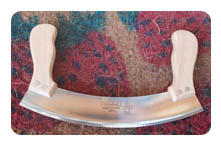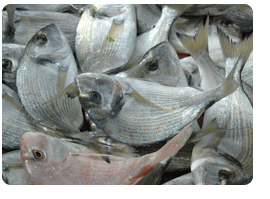A Cuisine for all Tastes, and a Taste for all Cuisines
One of the most famous traditional Turkish dishes in Egypt is Sharkassiyya (which, as its name indicates, is probably originally Circassian). Cooked with walnuts, it is considered a delicacy, and families will compete in preparing it. Not so common, however, is the cold Sharkassiyya, a specialty of Najla Kutay, one of the few remaining Alexandrian Turks who hold on to their heritage:
Cold Circassian Chicken
Sharkassiyya
1 chicken, cooked and deboned
10 slices toast, crust removed a day ahead and left to dry
Reserved chicken broth
½ kg walnuts, ground
1 garlic clove, mashed
Pinch of chili powder
- Place toast in a bowl and add enough chicken broth to soak toast.
- Add garlic and walnuts to toast then transfer to a blender and blitz until smooth.
- Pour over deboned chicken and fold in.
- Spoon into a serving dish and garnish with chili powder.

Not only walnuts but all nuts are used by the Turks in their cuisine, whether for main meals or for dessert. As nuts are expensive in Egypt, and during the Nasserite socialist regime of the 1960s were almost totally unavailable, peanuts are often used as a substitute. Yoghurt is a staple ingredient, sometimes eaten with sugar sprinkled on top, but always accompanying kebabs (unlike the Syrian-Lebanese, who will eat their kebabs with hummous (chickpea paste). Turks will often have old cheese for breakfast, which is called gebna Torki (Turkish cheese) in Cairo, or gebna Rûmi (referring to Rumelia, the European part of Turkey) in Alexandria, and which is also a great favorite with Egyptians, along with white cheese (gebna beida). Like the Egyptians, too, Turks will eat white cheese with watermelon, but they will make other combinations such as avocado and honey. Grain, bread, vegetables and pastries stuffed with almost anything: these are, like the Egyptian diet, staples ingredients in Turkish food.

Thus the kitchen in Alexandrian embraced some elements, rejected others, and held fast to some traditions. Ful (fava beans) is eaten by all, rich or poor (though it is said that princes would have it for breakfast, employees for lunch and paupers for supper). Traditionally, ful medammes was cooked in a special pot for eight hours over a low fire, but today families will buy it already cooked, and would simply add the condiments they prefer. That could be anything from heated butter or samna, or olive oil and lemon, or sausages, eggs, pastrami. The twin of ful is falafel, a fried patty made of fava beans, and often ful and falafel would be served together. Not perfect for the colon (though cumin is added to combat bloating), but a hearty, cheap and easily the most popular meal in Egypt, it is often served with pickles and greens. In Cairo, falafel is called ta’miyya, so the word falafel in Alexandria is probably an import from Belad el Sham, where they eat their ful and falafel mixed with chickpeas, though that hasn’t caught on 
In Alexandria. The famous ful Iskandarani is spiced up with cumin, chili powder, and diced green pepper, onions and tomatoes. Alexandrians seem to prefer their food spicier and hotter than the Cairenes, and so their liver is special too. Kebda Iskandarani, as it is called, is also made with chili and green pepper, cumin, lemon and thyme, probably an influence from the Lebanese who often use the two in their cooking. Cumin seems to be the ingredient that differentiates Alexandrian from Cairene food. After ful comes molokhiyya. That is jew’s mallow cut up very very finely and boiled with chicken broth to make a sort of green soup. Many families will have it on the Friday or the Sunday as the treat of the holy day, including foreigners. At first repulsed by its strange nature and the fried garlic which is tossed on top, members of the foreign community gradually come to love it and include it in their weekly fare when it is in season (summer). Jacques Felix Mawas, an Egyptian Jew descended from Rosette de Menasce, a French grandmother on the maternal side, grew up in a house that served French cuisine. Here he describes the eating habits of his family:

At home we had European meals but my paternal family remained essentially Oriental. So, for example, there would be a roast and potatoes, and then one of my aunts would ask of the domestics “What have you got in the kitchen?” And they would get her the molokhiyya that they were having. But when we had guests it was European cuisine. We had a superb Italo-Serbian cook who did a wonderful job. (Voices from Cosmopolitan Alexandria, p. 40)
It is interesting to note that among the domestics there was a preference for the local tasty molokhiyya over European food. Molokheyya is drunk like a soup, eaten with bread (cat’s ear) and with rice. Some families will serve it with a special fatta (rice and bread) and homes will vie with each other about the molokhiyya they serve. Some will boast that theirs is the best in the city, as does the family of Helmy el Kholy:

Fattet Melokhiyya El Kholy
1½ kg melokhiyya leaves, washed and patted dry
3 cups chicken broth
Salt and pepper to taste
1 to 2 cups rice, cooked
2 garlic cloves, chopped
1½ tbsp oil
1 tbsp garlic, chopped
½ tbsp ground coriander
3 loaves of crunchy whole wheat pita bread
Pickled cucumbers, chopped
Onions, sliced
Vinegar, to taste
Pinch of cumin
- Mince melokhiyya leaves using an herb chopper and place in a pot.
- Bring chicken broth to the boil in a saucepan and gradually temper it in with the minced melokhiyya leaves, adding just enough to reach a thick consistency.
- Add the first amount of garlic to the thick soup and stir until it begins to boil lowering heat immediately at this stage.
- Add oil to a sauté pan over medium heat and add second amount of garlic stirring until garlic turns golden. Add the coriander and stir then remove from heat.
- Pour garlic and coriander mixture onto the melokhiyya and remove from heat. Do not place lid over melokhiyya at this stage.
- Break crunchy bread pieces into a deep serving dish.
- Add just enough melokhiyya over bread to soften. Too much melokhiyya will make bread soggy.
- Cover this with a thin layer of rice.
- Garnish with pickled cucumber, onions, vinegar and a pinch of cumin.

Being a coastal city, fish, crabs, lobsters, sea urchins and shellfish such as mussels (om el kholoul) and clams (gandofli) are eaten with relish in Alexandria, though some things are no longer as commonplace as they used to be, such as fried whitebait (bisarya, also known as frittura) or sea urchins (ritza). After a meal of fish, Alexandrians will rub their hands with fresh lemon juice to remove the “fishy” smell. (In the trendier fish restaurants, halved lemons will be presented neatly wrapped in gauze; the lemon then can be squeezed and the seeds/pips safely screened) A preferred dessert after a typical fish meal would be guavas if they are in season, which is interesting given their very high content in vitamin C, a great adjuvant to the zinc in sea food, and the anti scurvy vitamin par excellence. In another context, the saying goes “Enn asmaktou, fa ablehhou”, or “If you've had fish to eat, then a date is in order”; an explanation not as readily available as with the above. In terms of combinations, it will be noted that a favorite Alexandrian accompaniment to grey mullet is a clay pot of aubergines, an ingredient otherwise also found in the baba ghannoug salad (aubergine and tahini) that accompanies fish as it does kofta and kebab. It could be observed that grilling is a process that agrees with aubergine, since it will be noted that to prepare baba ghannoug the aubergine is first grilled or put to roast in an oven before it is mashed and added to the tahini and then seasoned with lemon juice. All are ingredients that mix happily together.

After a meal of fish, Egyptians drink tea (preferably with mint, out of a glass, not cup). The idea is probably that tea slakes the thirst brought on by fried food. However, the explanation Alexandrians supply is that “fish likes swimming”. Tea would also counter the lulling effect of an often copious meal, made even more so by the minerals found in sea food, and which in turn may account for a renowned laid-back attitude encountered in the citizens of Alexandria.
1 2 3 4 5 6 7